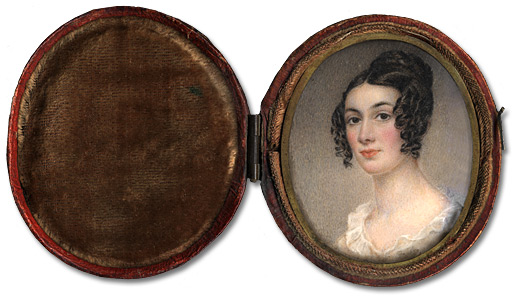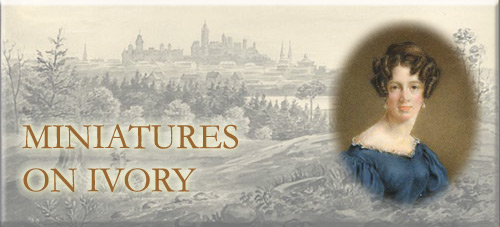
Table of Contents
Home | The Early Years | The Grand Tour | The Grand Tour- Continued
Britain - 1821-1837 | Miniatures on Ivory | Emigration - 1837
Settlement - 1837-1852 | Settlement - Continued | Peterborough and Toronto - 1852-1859
Britain & Canada: Tours and Vacations - 1860-1864 | Britain & Canada -1865-1878
Niagara, Ottawa, and Toronto - 1870s, 1880s
The Final Years | Langton Family and Family Connections | Preserving of the Collection
Resources and Acknowledgements
A significant aspect of Langton's art during the 1820s and '30s consisted of miniatures that she painted in watercolour on ivory. She had been introduced to the technique in Paris, and had continued to receive training under Thomas Hargreaves, R.A., a well-known Liverpool miniaturist. Two of Anne’s early miniatures on ivory depict her parents, Ellen Langton, in 1825, and Thomas Langton, in 1827. Anne painted these portraits in England, in the years immediately preceding and following the family’s change of fortune. The ivories, which were acquired by the Archives in 2006, are shown here alongside their sketched counterparts from Anne’s Studio Journals. |
||
Click to see a larger image (90K) Mrs. Thomas Langton (née Ellen Currer), 1825 Anne Langton Graphite on cream wove paper Reference Code: F 1077-7-3-1-18 Archives of Ontario, I0008310 |
Click to see a larger image (153K) Mrs. Thomas Langton (née Ellen Currer), 1825 Anne Langton Watercolour on ivory Reference Code: F 1077-7-1-0-21 Archives of Ontario, I0027763 |
|
|
Click to see a larger image (108K) Thomas Langton, 1827 Anne Langton Graphite on cream wove paper Reference Code: F 1077-7-3-1-10 Archives of Ontario, I0008302 |
Click to see a larger image (125K) Thomas Langton, 1827 Anne Langton Watercolour on ivory Reference Code: F 1077-7-1-0-22 Archives of Ontario, I0027764 |
|
Click to see a larger image (75K) William Langton [1831 or 1833] Anne Langton Watercolour on ivory Reference Code: F 1077-7-1-0-10 Archives of Ontario, I0008559 |
Langton portrays her elder brother William as a sensitive, cultivated, young "man about town." William spent the 1820s learning about the world of finance and commerce in the business houses of Langton family colleagues, first in London, then Liverpool. By 1831, he was about to settle in Manchester as Chief Cashier at a bank owned by the Heywood family. Soon afterwards, Benjamin (later, Sir Benjamin) Heywood, prominent banker and philanthropist, would appoint William as Manager. From that point on, William's career and fortune were to flourish, unhindered. He eventually became a noted Manchester philanthropist and social reformer, connoisseur of the arts and an expert in heraldry. By 1836, William was already so successful that he offered to pay his parents, sister's and aunt's living expenses to enable them to remain in England. Thomas, proud as ever, declined the offer, but finally agreed to allow William to pay off his creditors. |
|
Anne later wrote,
|
||
William and his family were the chief recipients of the "Canadian" Langtons' correspondence following their emigration; he, in turn, was their principal correspondent. For years after her arrival in Canada, Anne expressed a strong wish that William and his wife Margaret would make a trip to Canada, though she acknowledged that Margaret might not be willing to make the voyage. Over time, she reconciled herself to the fact that their visit would never take place. Fortunately, several of William's and Margaret's children did visit Canada over the following decades, thus providing Anne with the pleasure of sharing her Canadian environment firsthand. She chaperoned them on tours to such places as Quebec, Montreal, Ottawa, Toronto, Niagara, Peterborough, Blythe Farm and the Kawartha Lakes District, adding new images of these places to her sketchbook as they travelled and as her art matured over the years. |
||
This portrait (right), an important item in the recent donation to the Langton collection, superbly reveals Langton's miniaturist talents. Margaret Hornby, a wealthy heiress, is seen here in 1831, the year she married William Langton. |
Click to see a larger image (68K) ["my sister-in-law [Margaret Hornby] before she was married"], 1831 Anne Langton Watercolour on ivory Reference Code: F 1077-7-1-0-16 Archives of Ontario, I0008576 |
|
|
Click to see a larger image (35K) My sister-in-law Margaret, before she was married [fiance of WIlliam Langton], 1831 Anne Langton Graphite on cream wove paper Reference Code: F 1077-7-3-2-6 Archives of Ontario, I0008280 | ||
Langton's increased confidence and technical ability, here, capture the grace and beauty of the young bride-to-be. With judicious use of varied hatching strokes, stippling, tiny dabs of paint, broad brushstrokes, she models different tactile and visual elements: the delicate muslin gown, the rose at Margaret's waist, the sheen of her curls, her blush-toned complexion. Above all, Langton's gift for capturing the expressiveness of eyes and mouth brings this sitter to life, even today. In a rare moment of favourable self-appraisal, Anne Langton wrote of this miniature in 1839:
This and the portrait of William, above, were almost certainly painted as a companion souvenir pair to commemorate either their engagement, or marriage, in 1831. |
||
Thomas and John, depicted in the painting to the right as cultured gentlemen, peruse maps - presumably of Upper Canada - in anticipation of John's upcoming venture. Both were keenly interested in the burgeoning, nineteenth-century expansion in intellectual, scientific, and exploration fields. Thomas, now in his early sixties, was still attempting to recoup his losses by a variety of means, but with little success. He ran for municipal office, only to lose the election by one vote; appointed as Manager at a newly-opened branch of the Rothschild bank in Liverpool, he was terminated after only two years when the bank needed to introduce economies. |
Click to see a larger image (67K) Thomas Langton and son, John, 1833 Anne Langton Watercolour on ivory Reference Code: F 1077-7-1-0-8 Archives of Ontario, I0008575 | |
|
John, meanwhile, had graduated from Cambridge. Aspiring to be a lawyer, he was unable to pursue further studies in order to qualify, owing to lack of funds. At this point, having worked for a while in a lawyer's office in Liverpool and not feeling suited to becoming a member of the clergy, as his mother wished him to be, he turned to emigration as an alternative way to establish himself in the world. |
||
Click to see a larger image Mrs. Thomas Langton (née Ellen Currer). 1833 Anne Langton Watercolour on ivory Reference Code: F 1077-7-1-0-9 Archives of Ontario, I0008510 |
Here, sixty-six year-old Ellen, Anne's mother, head resting on her hand, appears somewhat world-weary from all her travels and trials. This and the miniatures above form a "gallery" of family portraits painted by Anne Langton shortly before her brother John emigrated to Upper Canada, likely as mementoes for him to carry to the New World. By now, Anne's skill for portraiture is well-honed. Through careful posing of each sitter, fine rendering of costume details and textures, modelling of complexion, skin tones, facial expression and the inclusion of appropriate accoutrements, she conjures up the individual character and inner personality of each subject. |
|
In this self-portrait Anne portrays herself as a quintessential gentlewoman, refined and elegant. At age twenty-nine, however, lacking fortune and social opportunities and, already experiencing hearing impairment, she is still unmarried. Despite all efforts, the family's fortunes never recovered. In 1833, John Langton, now a Cambridge graduate, emigrated to Upper Canada. After John's departure for Canada, the family moved into a still smaller house. |
Click to see a larger image (76K) Anne Langton: self-portrait, 1833 Anne Langton Watercolour on ivory Reference Code: F 1077-7-1-0-2 Archives of Ontario, I0008560 |
|
Click to see a larger image (102K) Miss [Alice] Currer, 1835 Anne Langton Watercolour on ivory Reference Code: F 1077-7-1-0-1 Archives of Ontario, I0008569 |
"Aunt Alice", (sister of Ellen Langton) became the role model for Langton's own life, the unselfish "maiden aunt": the ever-willing, dependable (and economically dependent), aid to the family as need arose.
|
|
Click to see a larger image (217K) Miss Harriet Lowe, 1836 Anne Langton Watercolour on ivory Reference Code: F 1077-7-1-0-23 Archives of Ontario, I0028020 |
||
The final entry in Anne’s record of portraits painted is of her close friend, Harriet Lowe, 1836. Harriet was one of three Lowe sisters, with whom Anne was very close. Like Anne, the sisters never married, and chose to open a private school for young ladies near London, England. This portrait shows the culmination of Anne’s years of experience in painting miniatures, as the details of Harriet’s dress and hair are delicately rendered. Anne has expertly captured the sitter’s features to give her a confident yet demure expression. Given that the ivory is less than 50 mm wide, the accuracy of detail is remarkable. |
||
|
In 1837 William, Ellen, Alice Currer and Anne decided to emigrate to Canada to join John, in full realization that their "Canada project" was "rather a wild scheme" for three elderly people and a young unmarried woman (SOF, 45, 46). |
||
The Early Years | The Grand Tour | The Grand Tour- Continued
Britain - 1821-1837 | Miniatures on Ivory | Emigration - 1837
Settlement - 1837-1852 | Settlement - Continued | Peterborough and Toronto - 1852-1859
Britain & Canada: Tours and Vacations - 1860-1864 | Britain & Canada -1865-1878
Niagara, Ottawa, and Toronto - 1870s, 1880s
The Final Years | Langton Family and Family Connections | Preserving of the Collection
Resources and Acknowledgements
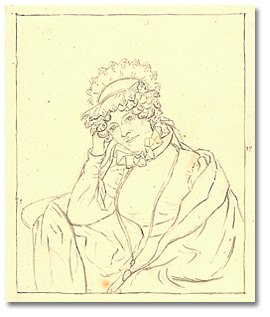
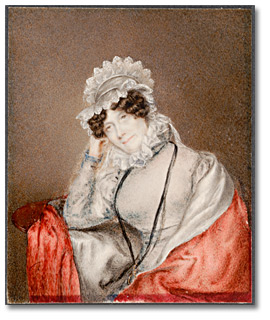
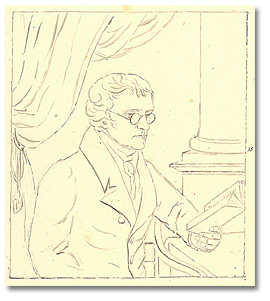
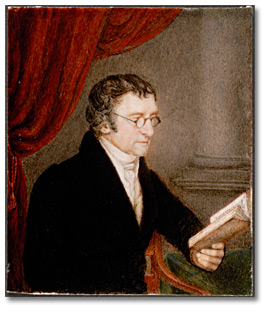
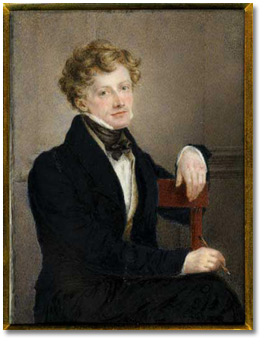
![["my sister-in-law [Margaret Hornby] before she was married"], 1831](pics/8576_margaret_oval.jpg)
![My sister-in-law Margaret, before she was married [fiance of WIlliam Langton], 1831](pics/8280_margaret_hornby.jpg)
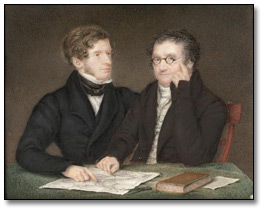
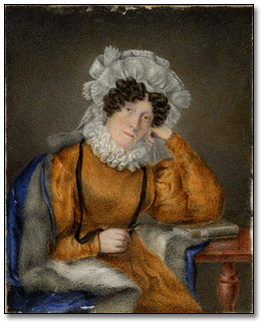
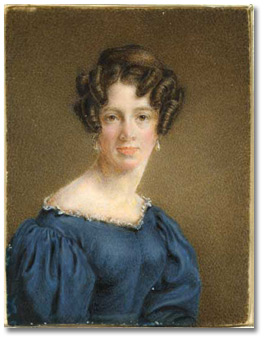
![Miss [Alice] Currer, 1835](pics/8569_alice_c_with_frame.jpg)
